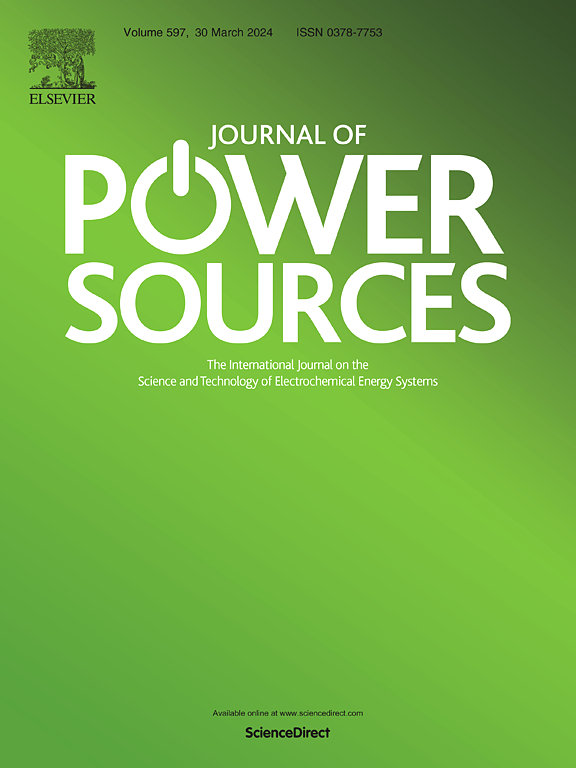Template-free water splitting preparation of carbon nanotube foam for high-efficiency charge storage and electromagnetic interference shielding
IF 8.1
2区 工程技术
Q1 CHEMISTRY, PHYSICAL
引用次数: 0
Abstract
With the wide applications of wearable and portable devices, there is a rising requirement to construct multi-functional materials featuring both high-efficiency charge storage and electromagnetic interference (EMI) shielding effectiveness (SE). Here, a facile template-free water splitting process is put forward by treating carbon nanotube paper (CNTP) to obtain carbon nanotube foam (CNTF). The resulting CNTF serving as electrode yields the specific capacitance as high as 513.8 F g−1 at 1 A g−1 and outstanding EMI SE of 74.7 dB, while those of CNTP are 21.4 F g−1 and 46.1 dB, respectively. When used as the current collector, CNTF demonstrates significant benefits for the efficient utilization of polyaniline (PANi) by the elimination of the distinct interface between the current collector and the active material. Additionally, PANi exhibits increased roughness and a higher degree of doping when combined with CNTF. The CNTF/PANi electrode, with a PANi loading of 3.63 mg cm−2, achieves the areal-specific capacitance of 2035.6 mF cm−2, over twofold higher than that for the CNTP/PANi electrode. A flexible electrochemical capacitor assembled by CNTF/PANi electrodes exhibits 85.6 % of capacitance retention ratio after bending for 1000 times, while a device based on CNTP/PANi electrodes only retains 31.3 %.
无模板水裂解制备碳纳米管泡沫的高效电荷存储和电磁干扰屏蔽
随着可穿戴和便携式设备的广泛应用,人们对既能高效存储电荷又能有效屏蔽电磁干扰的多功能材料提出了更高的要求。本文提出了一种简单的无模板水裂解工艺,通过处理碳纳米管纸(CNTP)得到碳纳米管泡沫(CNTF)。所得到的CNTF作为电极,在1 A g−1时的比电容高达513.8 F g−1,EMI SE为74.7 dB,而CNTP的比电容分别为21.4 F g−1和46.1 dB。当用作电流收集器时,CNTF通过消除电流收集器和活性材料之间的明显界面,显示出有效利用聚苯胺(PANi)的显着优势。此外,当与CNTF结合时,聚苯胺表现出更高的粗糙度和更高的掺杂程度。CNTF/PANi电极的面积比电容为2035.6 mF cm - 2,比CNTP/PANi电极的面积比电容高2倍以上,其PANi负载为3.63 mg cm - 2。由CNTF/PANi电极组装的柔性电化学电容器在弯曲1000次后的电容保留率为85.6%,而基于CNTP/PANi电极的器件仅保留31.3%。
本文章由计算机程序翻译,如有差异,请以英文原文为准。
求助全文
约1分钟内获得全文
求助全文
来源期刊

Journal of Power Sources
工程技术-电化学
CiteScore
16.40
自引率
6.50%
发文量
1249
审稿时长
36 days
期刊介绍:
The Journal of Power Sources is a publication catering to researchers and technologists interested in various aspects of the science, technology, and applications of electrochemical power sources. It covers original research and reviews on primary and secondary batteries, fuel cells, supercapacitors, and photo-electrochemical cells.
Topics considered include the research, development and applications of nanomaterials and novel componentry for these devices. Examples of applications of these electrochemical power sources include:
• Portable electronics
• Electric and Hybrid Electric Vehicles
• Uninterruptible Power Supply (UPS) systems
• Storage of renewable energy
• Satellites and deep space probes
• Boats and ships, drones and aircrafts
• Wearable energy storage systems
 求助内容:
求助内容: 应助结果提醒方式:
应助结果提醒方式:


